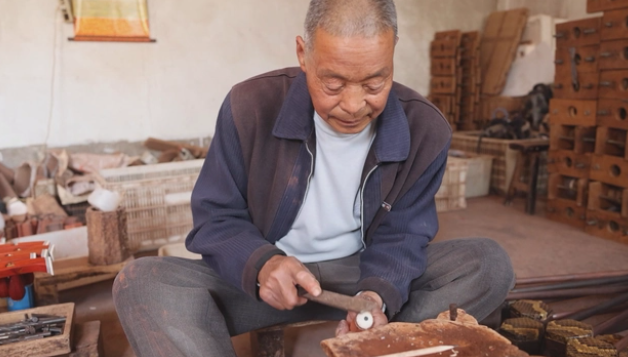Tancheng erhu, pull out the "happy music" of rural revitalization
Blanking, polishing, waxing, splicing, debugging... Although it is early winter, every household in Lequan Village, Miaoshan Town, Tancheng County, Shandong Province has its courtyard door open, and people are methodically processing groups of wood in the courtyard. With the hum of machine operation, erhu has taken shape.
"Come in and have a look!" Gao Zhenbao, a villager, warmly greeted the reporter to the house. In the room, a calligraphy scroll with the theme of "the sound of the piano" hangs high in the center, and all kinds of certificates, trophies and exhibition certificates, large and small, are neatly placed beside it.
Gao Zhenbao is a famous local expert in erhu production. Since he was 15 or 16 years old, he has learned the craft of erhu production from his father. According to him, in the 1940s, his father went south to Suzhou and other places for many times to learn skills and set up the "Gao's Musical Instrument Workshop". But at that time, the type of raw materials was single, and for other reasons, the sales volume was not high.
After the reform and opening up, people in Yuequan regard musical instrument making as a means of getting rich. To this end, a local association for the manufacture of ethnic musical instruments has been established to organize people to visit and study in Hangzhou, Shanghai and other places. "After returning from school, everyone set up their own factories in the courtyard, and the musical instrument industry gradually developed." Gao Zhenbao said.

At present, the musical instrument industry in Lequan Village is dominated by erhu, with 105 households producing it, accounting for more than 85% of the total households in the village. "On average, each family can make hundreds of them every month, and the farmers who farm the land have gradually become experts in piano making." Gao Qinglin, the party branch secretary of Lequan Village, said.
Gao Zhenbao is 74 years old this year. Under his influence, his three sons and daughter-in-law also joined the production team of erhu. At present, their family can produce more than 1000 erhu every year, with prices ranging from hundreds of yuan to tens of thousands of yuan. Their orders are all over the country, and some are also exported to the United States, Australia and other countries.
In recent years, the younger generation is growing into a new force in erhu production, and Gao Chao, a young man of the post-90s generation, is one of them.
At 11 o'clock at noon, when the reporter saw him, he walked out of the house drowsily. "Yesterday was broadcast live until one or two in the morning." He explained with a smile. In order to expand the market, the couple started to carry goods live on the short video platform since last September.
Red sandalwood, mahogany, octagonal, cylindrical... In their live broadcast room, erhu of different materials and specifications are hung on the wall, which makes people dizzy. In order to facilitate the selection of customers, they also made marks on the body of the piano. "Our account now has more than 50000 fans, which can be broadcasted for 3-5 hours every night, and can sell more than 500 pieces in a month at most." Gao Chao said.

"Taking the opportunity of the 'Shandong Handmade' promotion project, we are relying on the local erhu industry resources to build a national erhu (intangible cultural heritage) cultural industry cluster integrating production, exhibition, logistics, etc., to achieve the development from 'one person's skill' to 'one town's industry', radiating and driving the common revitalization of surrounding villages." Zhao Anning, secretary of the Miaoshan Town Party Committee, said.
Since 2016, Lequan Village has held an erhu production craft competition every year, inviting erhu craftsmen from all over the country to exchange their production skills and experience. Nowadays, the Erhu Culture Square, Erhu Museum and other venues have sprung up in Lequan Village, where the industry is prosperous and the days are prosperous. People are playing the "happy music" of rural revitalization in this white wall and black tiles.
 渝公网安备 50010702504639号
渝公网安备 50010702504639号